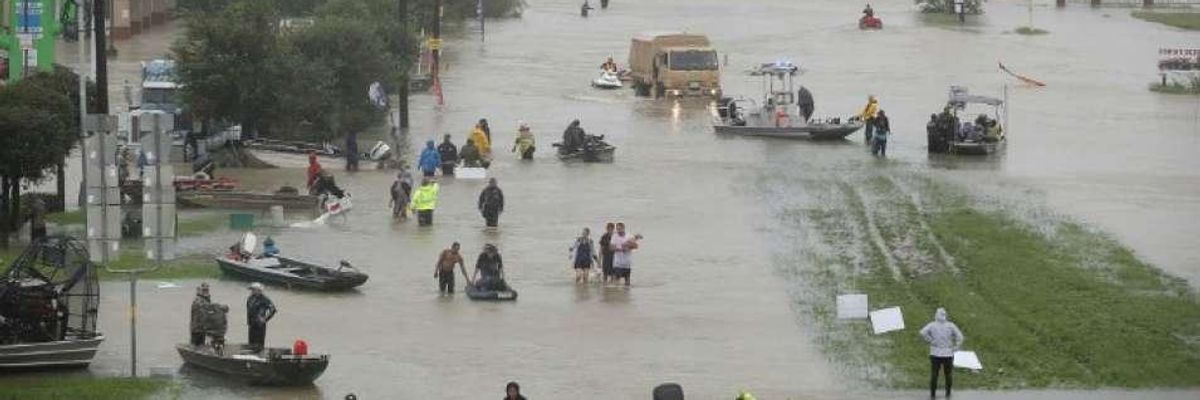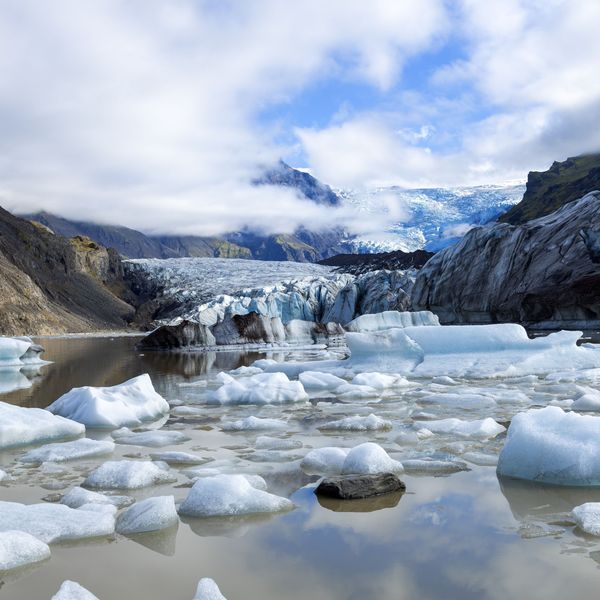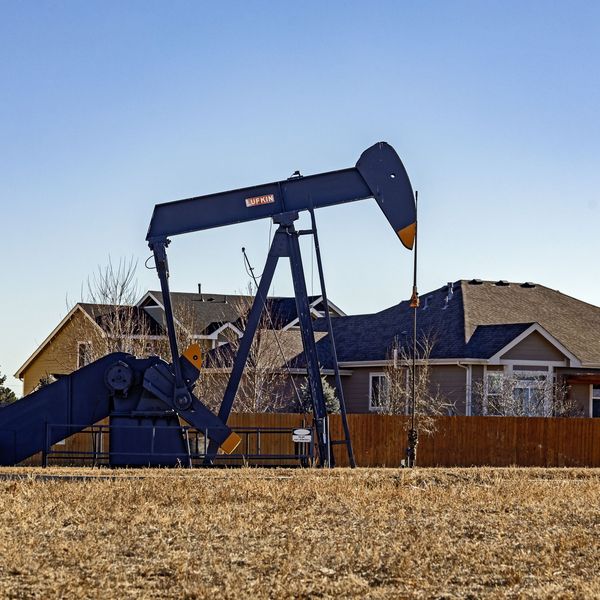
People walk down a flooded street as they evacuate their homes after the area was inundated with flooding from Hurricane Harvey on August 28, 2017 in Houston, Texas. (Photo: Joe Raedle/Getty Images)
'Part of a Disturbing Trend of Willful Ignorance,' Say Scientists, After Investigation Shows EPA, Texas Rejected Air Quality Data Post-Hurricane Harvey
New reporting in Los Angeles Times reveals Trump administration's disregard for data, science, public health, environment following 2017 catastrophic storm
President Donald Trump's Environmental Protection Agency and Texas state officials rejected an offer from NASA scientists in 2017 to use their state-of-the-art flying laboratory to evaluate air quality in Houston after Hurricane Harvey, new reporting by the Los Angeles Times reveals.
"This is disturbing," said Lina Hidalgo, judge for Texas's Harris County.
Harvey brought historic rainfall, catastrophic flooding, and triggered potentially dangerous environmental and public health impacts: Houston's many refineries and petrochemical released pollutants into the air and waters, and area residents began to complain of worrisome smells and toxic sights near the facilities, as well as symptoms including headaches. The EPA asserted that the air quality posed no threat.
NASA, it turned out, was in a good position to gather data on air quality in the area with its DC-8. The jet, whose ability to ability to gather data dwarfs that of the EPA's air pollution plane or the hand-held devices used by Texas state officials, was already set up for testing because of a scheduled six-hour test flight to Lamont, Oklahoma on Sept. 14.
The response to NASA's offer? Thanks but no thanks.
Susanne Rust and Louis Sahagun reported for the Times:
On Sept. 9, David Gray, the EPA's deputy regional administrator in Texas and leader of the agency's emergency response, wrote to NASA and Texas officials that he was "hesitant" to have the jet "collect additional information that overlaps our existing efforts" until he learned more about the mission. He noted that media and nongovernmental organizations were releasing data that was "conflicting" with the state and EPA's.
The NASA scientists offered assurances that their fact-finding would not get in the way, but noted that the data would eventually be seen by the public. Texas and the EPA were unmoved.
The state-level response came from director of toxicology Michael Honeycutt, who now heads EPA's Science Advisory Board and is known for expressing views well out of the reach of mainstream science, such as the idea that lowering ozone would be bad for public health.
On Sept. 11, Honeycutt wrote in an email to NASA and EPA officials that state data showed no sign for concern, and "we don't think your data would be useful for source identification while industry continues to restart their operations."
Gray agreed with Honeycutt: "EPA concurs with your assessment and we will not plan to ask NASA to conduct this mission."
Associated Press reporter Frank Bajak noted that the new investigation adds weight to his own news agency's previous reporting showing that "Texas environmental regulators had little interest in exposing most post-Harvey industrial contamination."
Reacting to the reporting on Twitter, Dr. Chelsea Thompson, a research scientist in atmospheric chemistry, wrote, "It's worth noting that, over a year later now, all of us involved are still stunned by how this played out."
\u201cAnother, more colorful, take on this debacle from @CharlesPPierce @esquire.\nIt's worth noting that, over a year later now, all of us involved are still stunned by how this played out. \nhttps://t.co/OsxAIpWZVV\u201d— Dr. Chelsea Thompson \u2744\ufe0f (@Dr. Chelsea Thompson \u2744\ufe0f) 1551802795
Another scientist, air pollution expert Nick Vizenor, who said he was part of lab team preparing for the potential mission over Houston, said the new investigation shows the "EPA and the state of Texas did not want to have all the information it could to try and help and protect the citizens of Houston."
"This is yet another story that shows how little the current administration cares about [its] citizens and the environment," he said.
\u201cThen, just as quickly as we had been informed that the DC-8 was headed to Houston, the mission was cancelled. The entire team in the lab was frustrated and confused. Why did NASA need permission? Why did the EPA say no? Who made those decisions?\u201d— Nick Vizenor (@Nick Vizenor) 1551808379
\u201cMore data is never a bad thing. The DC-8 would have provided data that supported the work that was being done on the ground, not hampered it. The EPA didn't see it that way, and that is scary.\u201d— Nick Vizenor (@Nick Vizenor) 1551808379
\u201cThere will be more hurricanes. There will be more natural disasters. Shouldn't we have all the data we can about them to help plan for the future? Shouldn't the citizens of Houston had all the data at their disposal to protect themselves from potentially hazardous air quality?\u201d— Nick Vizenor (@Nick Vizenor) 1551808379
"EPA and the Texas Commission on Environmental Quality knew air pollution was one of the unseen dangers of Hurricane Harvey, but according to news reports they deliberately chose not to use every available tool to discover it," added Elena Craft, senior health scientist with Environmental Defense Fund. "Their rejection of NASA's plan to fly a pollution-spotting plane over Houston after the storm is an abdication of responsibility and part of a disturbing trend of willful ignorance."
"Their action," she continued, "caused unnecessary risk to the health and safety of Texas families."
An Urgent Message From Our Co-Founder
Dear Common Dreams reader, The U.S. is on a fast track to authoritarianism like nothing I've ever seen. Meanwhile, corporate news outlets are utterly capitulating to Trump, twisting their coverage to avoid drawing his ire while lining up to stuff cash in his pockets. That's why I believe that Common Dreams is doing the best and most consequential reporting that we've ever done. Our small but mighty team is a progressive reporting powerhouse, covering the news every day that the corporate media never will. Our mission has always been simple: To inform. To inspire. And to ignite change for the common good. Now here's the key piece that I want all our readers to understand: None of this would be possible without your financial support. That's not just some fundraising cliche. It's the absolute and literal truth. We don't accept corporate advertising and never will. We don't have a paywall because we don't think people should be blocked from critical news based on their ability to pay. Everything we do is funded by the donations of readers like you. Will you donate now to help power the nonprofit, independent reporting of Common Dreams? Thank you for being a vital member of our community. Together, we can keep independent journalism alive when it’s needed most. - Craig Brown, Co-founder |
President Donald Trump's Environmental Protection Agency and Texas state officials rejected an offer from NASA scientists in 2017 to use their state-of-the-art flying laboratory to evaluate air quality in Houston after Hurricane Harvey, new reporting by the Los Angeles Times reveals.
"This is disturbing," said Lina Hidalgo, judge for Texas's Harris County.
Harvey brought historic rainfall, catastrophic flooding, and triggered potentially dangerous environmental and public health impacts: Houston's many refineries and petrochemical released pollutants into the air and waters, and area residents began to complain of worrisome smells and toxic sights near the facilities, as well as symptoms including headaches. The EPA asserted that the air quality posed no threat.
NASA, it turned out, was in a good position to gather data on air quality in the area with its DC-8. The jet, whose ability to ability to gather data dwarfs that of the EPA's air pollution plane or the hand-held devices used by Texas state officials, was already set up for testing because of a scheduled six-hour test flight to Lamont, Oklahoma on Sept. 14.
The response to NASA's offer? Thanks but no thanks.
Susanne Rust and Louis Sahagun reported for the Times:
On Sept. 9, David Gray, the EPA's deputy regional administrator in Texas and leader of the agency's emergency response, wrote to NASA and Texas officials that he was "hesitant" to have the jet "collect additional information that overlaps our existing efforts" until he learned more about the mission. He noted that media and nongovernmental organizations were releasing data that was "conflicting" with the state and EPA's.
The NASA scientists offered assurances that their fact-finding would not get in the way, but noted that the data would eventually be seen by the public. Texas and the EPA were unmoved.
The state-level response came from director of toxicology Michael Honeycutt, who now heads EPA's Science Advisory Board and is known for expressing views well out of the reach of mainstream science, such as the idea that lowering ozone would be bad for public health.
On Sept. 11, Honeycutt wrote in an email to NASA and EPA officials that state data showed no sign for concern, and "we don't think your data would be useful for source identification while industry continues to restart their operations."
Gray agreed with Honeycutt: "EPA concurs with your assessment and we will not plan to ask NASA to conduct this mission."
Associated Press reporter Frank Bajak noted that the new investigation adds weight to his own news agency's previous reporting showing that "Texas environmental regulators had little interest in exposing most post-Harvey industrial contamination."
Reacting to the reporting on Twitter, Dr. Chelsea Thompson, a research scientist in atmospheric chemistry, wrote, "It's worth noting that, over a year later now, all of us involved are still stunned by how this played out."
\u201cAnother, more colorful, take on this debacle from @CharlesPPierce @esquire.\nIt's worth noting that, over a year later now, all of us involved are still stunned by how this played out. \nhttps://t.co/OsxAIpWZVV\u201d— Dr. Chelsea Thompson \u2744\ufe0f (@Dr. Chelsea Thompson \u2744\ufe0f) 1551802795
Another scientist, air pollution expert Nick Vizenor, who said he was part of lab team preparing for the potential mission over Houston, said the new investigation shows the "EPA and the state of Texas did not want to have all the information it could to try and help and protect the citizens of Houston."
"This is yet another story that shows how little the current administration cares about [its] citizens and the environment," he said.
\u201cThen, just as quickly as we had been informed that the DC-8 was headed to Houston, the mission was cancelled. The entire team in the lab was frustrated and confused. Why did NASA need permission? Why did the EPA say no? Who made those decisions?\u201d— Nick Vizenor (@Nick Vizenor) 1551808379
\u201cMore data is never a bad thing. The DC-8 would have provided data that supported the work that was being done on the ground, not hampered it. The EPA didn't see it that way, and that is scary.\u201d— Nick Vizenor (@Nick Vizenor) 1551808379
\u201cThere will be more hurricanes. There will be more natural disasters. Shouldn't we have all the data we can about them to help plan for the future? Shouldn't the citizens of Houston had all the data at their disposal to protect themselves from potentially hazardous air quality?\u201d— Nick Vizenor (@Nick Vizenor) 1551808379
"EPA and the Texas Commission on Environmental Quality knew air pollution was one of the unseen dangers of Hurricane Harvey, but according to news reports they deliberately chose not to use every available tool to discover it," added Elena Craft, senior health scientist with Environmental Defense Fund. "Their rejection of NASA's plan to fly a pollution-spotting plane over Houston after the storm is an abdication of responsibility and part of a disturbing trend of willful ignorance."
"Their action," she continued, "caused unnecessary risk to the health and safety of Texas families."
President Donald Trump's Environmental Protection Agency and Texas state officials rejected an offer from NASA scientists in 2017 to use their state-of-the-art flying laboratory to evaluate air quality in Houston after Hurricane Harvey, new reporting by the Los Angeles Times reveals.
"This is disturbing," said Lina Hidalgo, judge for Texas's Harris County.
Harvey brought historic rainfall, catastrophic flooding, and triggered potentially dangerous environmental and public health impacts: Houston's many refineries and petrochemical released pollutants into the air and waters, and area residents began to complain of worrisome smells and toxic sights near the facilities, as well as symptoms including headaches. The EPA asserted that the air quality posed no threat.
NASA, it turned out, was in a good position to gather data on air quality in the area with its DC-8. The jet, whose ability to ability to gather data dwarfs that of the EPA's air pollution plane or the hand-held devices used by Texas state officials, was already set up for testing because of a scheduled six-hour test flight to Lamont, Oklahoma on Sept. 14.
The response to NASA's offer? Thanks but no thanks.
Susanne Rust and Louis Sahagun reported for the Times:
On Sept. 9, David Gray, the EPA's deputy regional administrator in Texas and leader of the agency's emergency response, wrote to NASA and Texas officials that he was "hesitant" to have the jet "collect additional information that overlaps our existing efforts" until he learned more about the mission. He noted that media and nongovernmental organizations were releasing data that was "conflicting" with the state and EPA's.
The NASA scientists offered assurances that their fact-finding would not get in the way, but noted that the data would eventually be seen by the public. Texas and the EPA were unmoved.
The state-level response came from director of toxicology Michael Honeycutt, who now heads EPA's Science Advisory Board and is known for expressing views well out of the reach of mainstream science, such as the idea that lowering ozone would be bad for public health.
On Sept. 11, Honeycutt wrote in an email to NASA and EPA officials that state data showed no sign for concern, and "we don't think your data would be useful for source identification while industry continues to restart their operations."
Gray agreed with Honeycutt: "EPA concurs with your assessment and we will not plan to ask NASA to conduct this mission."
Associated Press reporter Frank Bajak noted that the new investigation adds weight to his own news agency's previous reporting showing that "Texas environmental regulators had little interest in exposing most post-Harvey industrial contamination."
Reacting to the reporting on Twitter, Dr. Chelsea Thompson, a research scientist in atmospheric chemistry, wrote, "It's worth noting that, over a year later now, all of us involved are still stunned by how this played out."
\u201cAnother, more colorful, take on this debacle from @CharlesPPierce @esquire.\nIt's worth noting that, over a year later now, all of us involved are still stunned by how this played out. \nhttps://t.co/OsxAIpWZVV\u201d— Dr. Chelsea Thompson \u2744\ufe0f (@Dr. Chelsea Thompson \u2744\ufe0f) 1551802795
Another scientist, air pollution expert Nick Vizenor, who said he was part of lab team preparing for the potential mission over Houston, said the new investigation shows the "EPA and the state of Texas did not want to have all the information it could to try and help and protect the citizens of Houston."
"This is yet another story that shows how little the current administration cares about [its] citizens and the environment," he said.
\u201cThen, just as quickly as we had been informed that the DC-8 was headed to Houston, the mission was cancelled. The entire team in the lab was frustrated and confused. Why did NASA need permission? Why did the EPA say no? Who made those decisions?\u201d— Nick Vizenor (@Nick Vizenor) 1551808379
\u201cMore data is never a bad thing. The DC-8 would have provided data that supported the work that was being done on the ground, not hampered it. The EPA didn't see it that way, and that is scary.\u201d— Nick Vizenor (@Nick Vizenor) 1551808379
\u201cThere will be more hurricanes. There will be more natural disasters. Shouldn't we have all the data we can about them to help plan for the future? Shouldn't the citizens of Houston had all the data at their disposal to protect themselves from potentially hazardous air quality?\u201d— Nick Vizenor (@Nick Vizenor) 1551808379
"EPA and the Texas Commission on Environmental Quality knew air pollution was one of the unseen dangers of Hurricane Harvey, but according to news reports they deliberately chose not to use every available tool to discover it," added Elena Craft, senior health scientist with Environmental Defense Fund. "Their rejection of NASA's plan to fly a pollution-spotting plane over Houston after the storm is an abdication of responsibility and part of a disturbing trend of willful ignorance."
"Their action," she continued, "caused unnecessary risk to the health and safety of Texas families."

